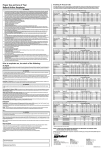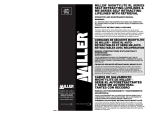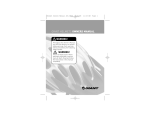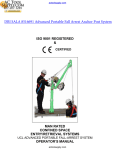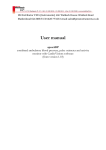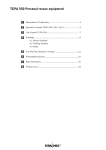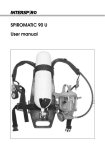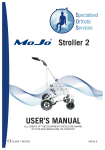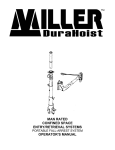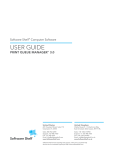Download Flexible Steel Tail Ropes
Transcript
Issued 3/05 Important User Instructions For Models TR3DPC, TR3SPC, TR10DPC and TR10SPC GENERAL: Both EN358 and ANSI 10.14 require users to be trained by a competent person before this tail rope is used on the job. Each unit shall be inspected every six months according to the manufacturer’s recommendation and the date of each inspection shall be recorded on the attached metal tag. Equipment showing any defect shall be withdrawn from service immediately. All fall protection systems subjected to impacts caused by a free fall or by testing shall be removed from service and should not be used again. INSPECTION: Each unit shall be visually inspected for defects prior to each use and particular attention should be directed to the following potential Damaged defects: (A) fraying (B) loose or damaged connection points or areas (C) damage due to Plastic Casing deterioration, (D) operational defects, (E) damaged or distorted snap hooks or faulty springs. Equipment showing any defect shall be withdrawn from service immediately. All Lewis Manufacturing Company safety equipment is inspected for quality assurance according to ANSI/ANQC Q9003-1991. The type TR3DPC rope Damaged also meets or exceeds the specifications connection of ANSI 10.14 (1991). The large metal Frayed tag riveted to it shows ANSI compliance. This tag is also used to register a perma- cable nent record of belt/tail rope inspection. A qualified person must inspect this safety device twice a year using the listed potential defects as a reference. The month and the year of inspection is recorded by marking the correct raised letter or number on the tag using a small hammer and a tool such as a center punch. The smaller tag denotes the following: 1. The individual serial number of the item. 2. The type as it appears in our catalog (EX. TYPE SC) (EX. TYPE TR-10-D-PC). 3. The work load of that particular item. Serial No. Type: Inspected By: Date: The fabric label attached to the rope indicates the EN358: 1992 number which the systems have also been proven to meet or exceed. Do not alter this rope in any way. Failure to use this rope properly may result in serious bodily harm. OILFIELD, INDUSTRIAL & UTILITY SUPPLIES Flexible Steel Tail Ropes STORAGE OF EQUIPMENT: Each unit should be stored in a cool, dry place and not subjected to direct sunlight. CLEANING INSTRUCTIONS: 1. Rope may be cleaned using warm water and a mild detergent. 2. Dry naturally, away from direct source of heat. Please keep this form along with the certification on file for the life of the products you are using. It is very important that these guidelines be followed in order to avoid serious injury or even death. If you have any questions regarding the use or inspection of any Lewis Manufacturing Company equipment, please feel free to call us collect at any time at (405) 634-5401. OILFIELD, INDUSTRIAL & UTILITY SUPPLIES The item in this box can be identified by referring to the following information: WARNING Do not alter any Lewis Manufacturing equipment in any way. Lewis Manufacturing does not assume any liability for accident or injuries resulting from a field-repaired or altered equipment. Instruction Manual Now accepting Visa and MasterCard. P.O. Box 95089 • 3601 S. Byers Oklahoma City, OK 73143 • (405) 634-5401 Toll Free: 1-888-398-4719 Fax: (405) 632-8608 • e-mail: [email protected] Snap Hook D-Ring Oilfield Tail Rope to be used with Climbing Belt, Fall Arrest Harness, Counterweight and Pulley for climbing derricks. Made of finest grade plastic coated aircraft cable. Available in 2’ through 14’ lengths in 2’ increments. Available with one snap hook and one 3” D-ring or snap hooks on both ends. Snap Hooks P.O. Box 95089 • 3601 S. Byers Oklahoma City, OK 73143 • (405) 634-5401 Toll Free: 1-888-398-4719 Fax: (405) 632-8608 • e-mail: [email protected] OILFIELD, INDUSTRIAL & UTILITY SUPPLIES How To Put On Lewis Tail Ropes The purpose of the Lewis Tail Rope is to provide the user a means of work positioning, and when the work requires, an anchor for leverage. Lewis Tail Ropes are not intended for fall arrest and / or fall deceleration. The user is required to utilize a deceleration lanyard (Slo-Stop) or other type of fall deceleration device in addition to our tail rope. (See photo) The tail rope must be used with a genuine Lewis Derrick Belt or Fall Arrest Harness for maximum safety. ALWAYS USE THE SHORTEST TAIL ROPE POSSIBLE Slo-Stop AND ALWAYS USE A FALL DECELERATION DEVICE. Lanyard TAIL ROPES AND FALL DECELERATION LANYARDS (Slo-Stop) SHOULD BE ARRANGED SO MAXIMUM FREE FALL IS 1.8 FEET (0.5 METERS). NEVER WRAP THE TAIL ROPE OR FALL DECELERATION Tail Rope DEVICE AROUND ANY TYPE OF STRUCTURE METALLIC OR OTHERWISE TO SHORTEN THE LENGTH OF SAID DEVICE. THIS CREATES AN ABRASION POINT AND CREATES UNNECESSARY FALL HAZARDS. The following tail ropes are manufactured in conformance with the provisions of the European Standard EN358-1992... (hence CE identification on those models) and shall, therefore, be used only as stipulated in those provisions. All Lewis tail ropes conform to ANSI 10.14 (1991). This operating instructions manual must always be kept available as long as the tail rope with which it was furnished is in service. The inspection tag on the tail rope shall be kept current as per instructions on the reverse side of this manual. -type examination by SGS Yarsley I.C.S., Ltd. Portland Road East Grinstead RH194ET (U.K.) (Notified body #0120) Climbing Belt Step # 1 Undo tail rope as illustrated. Fall Arrest Harness Step #2 Waist Band Level Attach Genuine Lewis Tail Rope to BOTH D-rings on a Climbing Belt as pictured at left or to rear waist-level D-ring on a Fall Arrest Harness as in the photo to the right. Always attach Tail Rope Snap to BOTH D-Rings. WARNING Do not alter any Lewis Manufacturing equipment in any way. This includes the removal of shoulder straps, leg straps, hardware or rivets. Alteration or improper use of this belt can result in severe bodily harm or even death. Lewis Manufacturing does not assume any liability for accident or injuries resulting from a field-repaired or altered equipment. Inspect Lewis Tail Ropes and Safety Belts twice yearly. Record inspection dates on tags attached to tail ropes, fall arrest harnesses and safety belts. P.O. Box 95089 • 3601 S. Byers Oklahoma City, OK 73143 • (405) 634-5401 Toll Free: 1-888-398-4719 Fax: (405) 632-8608 • e-mail: [email protected] WARNING Don’t use this Tailrope if you weigh more than 300 lbs.! (136 kg.) P.O. Box 95089 • 3601 S. Byers Oklahoma City, OK 73143 • (405) 634-5401 Toll Free: 1-888-398-4719 Fax: (405) 632-8608 • e-mail: [email protected] Important User Instructions 1.0 APPLICATIONS 1.1 PURPOSE: Lewis Manufacturing braided steel tail ropes should be limited to work positioning only. The Lewis braided steel tail ropes are not intended for fall arrest purposes. The Lewis Manufacturing Slo-Stop Lanyards are designed for fall deceleration only. The Lewis Manufacturing Retractable nylon lanyards are for work positioning only, and should not be used for fall deceleration. 1.2 The following application limitations must be considered before using any of these products: B. PHYSICAL AND ENVIRONMENTAL HAZARDS: Use of this equipment in areas containing physical or environmental hazards may require that additional precautions be taken to reduce the possibility of damage to this equipment or injury to the user. Hazards may include, but are not limited to: high heat, strong or caustic chemicals, corrosive environments, the possibility of electric current flowing through this equipment when working near high voltage power lines, explosive or toxic gases, moving machinery, or sharp edges. Contact Lewis Manufacturing if you have any questions about the application of this equipment in areas where physical or environmental hazards are present. C. TRAINING: This equipment is intended to be installed and used by persons who have been properly trained in its correct application and use. 1.3 Refer to national consensus (including ANSI Z359.1 and ANSI A10.14), applicable local, state, and federal (OSHA) requirements governing this equipment or for more information on Energy Absorbing Lanyards, Energy Absorbers and associated system components. COMPATIBILITY: Connectors are considered to be compatible with connecting elements when they have been designed to work together in such a way that their sizes and shapes do not cause their gate mechanisms to inadvertently open regardless of how they become oriented. Contact Lewis Manufacturing if you have any questions about compatibility. A. To a D-ring to which another connector is attached. B. In a manner that would result in a load on the gate. Note: Large throat opening snap hooks should not be connected to standard size D-rings or similar objects, which will result in a load on the gate if the hook or D- P. O . B o x 9 5 0 8 9 • 3601 S. Byers F. To any object which is shaped or dimensioned such that the snap hook or carabiners with not close and lock, or that roll-out could occur. D. FALL CLEARANCE: Should a fall occur, there must be sufficient clearance in the fall area to arrest the fall before striking the ground or other object. Energy absorbers can extend the fall arrest distance by up to 42 inches. Figure 4 shows how to estimate fall clearance distance when using an energy absorbing lanyard or energy absorber subsystem. Other factors may influence the required clearance distances. For example, using an energy absorbing lanyard or energy absorber with a rope grab (fall arrestor) may require additional clearance due to stretch in the lifeline or sliding of the rope grab on the lifeline during fall arrest. Some full body harness models incorporate a sliding (positional) D-ring in the back as the fall arrest attachment; movement of this D-ring during fall arrest can increase the fall clearance distance required. Use caution when assembling system components that could act to extend the fall arrest distance (and therefore fall clearance required). Refer to manufacturer’s instructions for each part of the system for more information on fall clearance. 2.3 ANCHORAGE STRENGTH: Anchorages selected for personal fall arrest systems (PFAS) shall have a strength capable of sustaining static loads, applied in the directions permitted by the PFAS, or at least: (A) 3,600 lbs. when certification exists (reference ANSI Z359.1 for certification definition), or (B) 5,000 lbs. in the absence of certification. When more than one PFAS is attached to an anchorage, the anchorage strengths set forth in (A) and (B) above must be multiplied by the number of PFAS attached to the anchorage. Per OSHA 1926.500 and 1910.66 Anchorages used for attachment of PFAS shall be independent of any anchorage being used to support or suspend platforms, and capable of supporting at least 5,000 lbs. per user attached, or be designed, installed, and used as part of a complete PFAS which maintains a safety factor of at least two, and is supervised by a qualified person. Swing Falls 2.1 COMPATIBILITY OF CONNECTORS: Lewis Manufacturing equipment is designed for use with Lewis manufacturing approved components and subsystems only. Substitutions or replacements made with nonapproved components or systems may jeopardize compatibility of equipment and may affect the safety and reliability of the complete system. Lewis Manufacturing connectors (snap hooks and carabiners) are designed to be used only as specified in each product’s user’s instructions. See Figure 3 for inappropriate connections. Lewis Manufacturing snap hooks and carabiners should not be connected: D. To each other 3.0 OPERATIONS AND USE 2.0 SYSTEM REQUIREMENTS 2.2 Making Connections: Use only self-locking snap hooks and carabiners with this equipment. Use only connectors that are suitable for each application. Ensure all connections are compatible in size, shape and strength. Do not use equipment that is not compatible. Ensure all connectors are fully closed and locked. C. In a false engagement, where features that protrude from the snap hook or carabiner catch on the anchor and without visual confirmation seems to be fully engaged to the anchor point. E. Directly to webbing or rope lanyard or tie-back (unless the manufacturer’s instructions for both the lanyard and connector specifically allows such a connection. A. CAPACITY: This equipment is for use by persons with a combined weight (person, clothing, tools, etc.) of no more than 300 lbs. Connectors (hooks, carabiners and D-rings) must be capable of supporting at least 5,000 lbs. (22kN). Connectors must be compatible with anchorage or other system components. Do not use equipment that is not compatible. Non-compatible connectors may unintentionally disengage. Connectors must be compatible in size, shape and length. Selflocking snap hooks and ANSI Z359.1 and OSHA require carabiners. ring twists or rotates. Large throat snap hooks are designed for use on fixed structural elements such as rebar or cross members that are not shaped in a way that can capture the gate of the hook. C. FALL ARREST FORCES: The assembled fall arrest system must keep fall arrest forces below 1,800 lbs. when used with a full body harness. WARNING: Do not alter or intentionally misuse this equipment. Consult Lewis Manufacturing when using this equipment in combination components or subsystems other than those described in this manual. Some subsystem and component combinations may interfere with the operation of this equipment. Use caution when using this equipment around moving machinery, electrical hazards, chemical hazards, and sharp edges. WARNING: Consult your doctor if there is reason to doubt your fitness to safely absorb the shock from a fall arrest. Age and fitness seriously affect a worker’s ability to withstand falls. Pregnant women or minors must not use Lewis Manufacturing energy absorbing lanyards or any other Lewis Manufacturing equipment. 3.1 BEFORE EACH USE of this equipment, carefully inspect it to assure that it is in good working condition. Check for worn or damaged parts. Ensure all hardware is present and secure, and is not distorted or have any sharp edges, burrs, cracks or corrosion. Ensure self-locking snap hooks or carabiners work properly. Inspect cables for cuts, burns, frayed edges, breaks or other damage. See section 5.0 for further inspection details, and always refer to user instructions for each specific product that you are using. Do not use if inspection reveals an unsafe condition. 3.2 PLAN your fall protection system before starting your work. Take into consideration factors that effect your safety before, during and after a fall. The following list gives some important points to consider when planning your system: A. ANCHORAGE: Select a rigid anchorage point that is capable of supporting the required loads. See section 2.3. The anchorage location must be carefully selected to reduce possible free fall and swing fall hazards and to avoid striking an object during a fall. The anchorage should be generally level (horizontal) to prevent the anchorage connector from sliding down an incline when in use, which could cause serious injury to the user. B. FREE FALL: Personal fall arrest systems must be rigged such that the potential free fall is never greater than 6 feet (5 feet per ANSI A10.14). Avoid working above your anchorage level to avoid an increased free fall distance. O k l a h o m a C i t y, O K 7 3 1 4 3 • (405) 634-5401 E. SWING FALLS: Swing falls occur when the anchorage point is not directly above the point where a fall occurs. The force of striking an object while swinging (horizontal speed of the user due to the pendulum affect) can be great and may cause serious injury. In a swing fall situation, the total vertical fall distance of the user will be greater than if the user had fallen vertically directly below the total free fall distance and the area needed to safely arrest the fall. Working as directly below the anchorage point as possible can minimize swing falls. Never permit a swing fall if injury could occur. If a swing fall situation exists in your application, contact Lewis Manufacturing before proceeding. F. SHARP EDGES: Avoid working where the Lanyard, Tai Rope, subsystem, or other system components will be in contact with, or abrade against, unprotected sharp edges. Do not loop lanyard or tail rope around small diameter structural members. If working with this equipment near sharp edges is unavoidable, protection against cutting must be provided by using a heavy pad or other means over the exposed sharp edge. G. RESCUE: Should a fall occur, the user (employer) must have a rescue plan and the ability to implement it. the possibility of rollout when making connections. Do not use hooks or connectors that will not completely close over the attachment object. For these situations, use a tie-off adapter or other anchorage connector to allow a compatible connection. Do not knot Lanyard or Tail Rope in any manner, and do not hook lanyard or Tail Ropes back into itself (choker style). Snap hooks and carabiners must not be connected to each other. Do not attach snap hooks to web loops. A. CONNECTING TO ANCHORAGE OR ANCHORAGE CONNECTOR: Always connect the energy absorber end of the lanyard to the body support (harness). Connect the lanyard end to the anchorage or anchorage connector. Component style energy absorbers should be connected to the body support first, and then coupled to the rest of the system. Some anchorage connector devices may be supplied with permanently attached energy absorber. Use of an additional energy absorber or energy absorbing lanyard with these types of subsystems is not recommended. 100% tieoff “Y” type energy absorbing lanyards can be used to provide continuous fall protection while ascending, descending, or moving laterally. With one lanyard leg attached, the worker can move to a new location, attach unused lanyard leg, and disconnect attached leg. This Anchorage Anchorage Connector Connector procedure is repeated Anchorage Connector until new location is reached. With the Energy Slo-Stop 100% tie-off Energy Connecting Absorbing Absorbing type lanyard, only one Subsystem Energy Lanyard Lanyard (Rope Grab) Absorbing leg of the lanyard Lanyard shall be attached to the anchorage connector once working location is reached. If using a Tail Rope with a D-Ring and Connecting to Anchorage Snap, run snap end around anchor point and back through the D-Ring, then attach locking snap to Middle D-Ring on back of Harness. Make sure that anchor points meet requirements in section 2.3. If using a Tail Rope with two snaps make sure that anchor point will support required load see section 2.3. Make sure that anchor point is free of sharp edges, metal burrs or any distortion that may cause undue wear and tear on the Tail Rope or Lanyard in use. If you have ANY concerns concerning you anchor point please call Lewis at 888-398-4719, we will be glad to help. 2.3. Attaching a Lanyard Anchor or Tieback Lanyard: Place the tieback lanyard over the anchoring structure. Ensure the lanyard is not twisted. Adjust the floating D-ring so it lands below the anchoring structure. Attach H. AFTER A FALL: Lanyards with integral energy absorbers, or energy absorber components which have been subjected to the forces of arresting a fall, must be removed from service and destroyed. WARNING: Read and follow manufacturer’s instructions for associated equipment (full body harness, Tail Ropes, Retractable Lanyards, rope grab, etc.) used in your fall protection system. Pull Back Gate With Thumb Push Inward Push Up Rotate Clockwise STEP THREE STEP TWO STEP ONE STEP ONE Depress Locking Mechanism With Index Finger STEP TWO IMPORTANT: For special (custom) versions of this product, follow the instructions herein. If included, see supplement for additional instructions. 3.3. MAKING CONNECTIONS: When using a hook to connect to an anchorage, or when coupling components of the system together, ensure accidental disengagement (roll-out) cannot occur. Rollout occurs when interference between a hook and the mating connector causes the hook’s gate or keeper to accidentally open and release. Rollout may occur when a hook is connected to an undersized ring such as an eyebolt or other noncompatible shaped connector. Self-locking snap hooks or self-locking and self-closing gate carabiners should be used to reduce To l l F r e e : 1 - 8 8 8 - 3 9 8 - 4 7 1 9 Push Inward Rotate Clockwise STEP ONE STEP ONE STEP TWO Depress Locking Mechanism With Palm of Hand Push Inward STEP TWO Making Connection Fax: (405) 632-8608 • e-mail: [email protected] the lanyard end hook to the floating D-ring. If using a Lewis Lanyard Anchor place the Lanyard Anchor around the Anchor point or structure, insert smaller D-Ring through larger D-Ring, Attach Lanyard or Tail rope to Lanyard anchor. Attaching a Lanyard with Wire Form Pipe Hook: The wire form pipe hook is intended for use with pipes up to three inches in diameter. The anchorage must be geometrically compatible in size and shape. Do not side load the pipe hook. Do not allow the pipe hook to contact electrical sources. Proper Connection Squeeze the handle to open the hook. Place hook around the anchorLoad age and release handle. Direction When connecting to an anchorage, ensure the hook fully closes and closure hooks engage IMPROPER eye loops on hook body. IMPROPER CONNECTION CONNECTION B. CONNECTING TO Load Direction THE BODY SUPPORT: Connect the energy Attaching Wire Form absorbing lanyard or energy absorber to the D-ring on the back between the shoulders (dorsal D-ring) on a full body harness. Connect so the energy absorber portion of the lanyard is on the body support side. Lewis Manufacturing does not recommend using a body belt for fall arrest applications. If using a body belt, connect the Insert lanyard web loop through web loop or D-ring on harness. C. CONNECTING TO A ROPE GRAB (FALL ARRESTOR): It is recommended the lanyard end (vs. the energy absorber end) be attached to the rope grab. This recommendation is made to reduce possible interference with the operation of the rope grab by the energy absorber “pack”. Attaching a component style energy absorber to a rope grab is not recommended, with the exception of a “direct-coupling” between a rope grab and a harness. Some rope grabs may be supplied with a permanently attached energy-absorbing lanyard. For these cases, use of an additional energy absorber connected between the rope grab and the body support is not recommended. In some cases, it may be permissible to couple an energy absorber component between the anchorage (or anchorage connector) and the rope grab lifeline. In all cases, ensure the length of the energy absorber or energy-absorbing lanyard does not exceed the rope grab manufacturers recommended maximum connection length (3 feet maximum per ANSI Z359.1). D. CONNECTING TO SELF RETRACTING LIFELINE: Lewis Manufacturing does not recommend connecting an energy absorbing lanyard or energy absorber component to a self-retracting lifeline. Special applications do exist where it may be permissible. Contact Lewis Manufacturing if considering connecting an energyabsorbing lanyard to a self-retracting lifeline. 3.4 After use, return the lanyard for cleaning or storage as described in section 6.0 energy absorbing lanyard or energy absorber to the D-ring and position the belt so the D-ring is located on the back side of the body. 4.1 It is the responsibility of all users of this equipment to understand these instructions, and to be trained in the correct installation, use and maintenance of this equipment. These individuals must be aware of the consequences of improper installation or use of this equipment. This user manual is not a substitute for a comprehensive training program. Training must be provided on a periodic basis to ensure proficiency of the users. Call Lewis at 888-398-4719 for information on training programs available. 5.2 INSPECTION STEPS PROPER CONNECTION Attaching Tie-Back P. O . B o x 9 5 0 8 9 • Attaching a Lanyard with Web Loops: 1. Insert the energy absorbing lanyard web loop through the harness web loop or D-ring. 2. Insert the opposite end of the energyabsorbing lanyard through the connecting web loop. 3. Pull the attached energy-absorbing lanyard through the connecting web loop to secure. 3601 S. Byers Step 1. Inspect energy absorbing lanyard or energy absorber component hardware (snap hooks, adjusters, swages, thimbles, etc.). These items must not be damaged, broken, distorted, or have any sharp edges, burrs cracks, worn parts, or corrosion. Ensure the connecting hooks work properly. Hook gates must move freely and lock upon closing. Ensure adjusters (if present) work properly. Step 2. Inspect the Tail Rope, Slo-Stop lanyard, Energy Absorber Component, or Retractable Lanyard per the following as applicable: WEBBING, STITCHING, AND CABLES: The webbing material and tail rope cables must be free of burned, melted, frayed, cut, or broken fibers or wires. Check for tears, abrasions, mold, burns, rust, or discoloration, etc. The webbing and cable must be free of knots, excessive discolored, or brittle areas. Check for ultraviolet damage indicated by discoloration and the presence of splinters or slivers on the webbing or cable surface. All of the above factors are known to reduce webbing and /or cable strength. Damaged or questionable webbing or cable should be replaced before use. Inspect stitching for pulled or cut stitches. O k l a h o m a C i t y, O K 7 3 1 4 3 All Lewis Slo-Stop lanyards are manufactured with a one inch long section of red safety stitching at the base of the yellow containment sleeve. When this red stitching is torn or missing, the Slo-Stop unit has been deployed and MUST be removed from service and replaced immediately. Step 5. Inspect each system component or subsystem per associated manufacturer’s instruction. 4.0 TRAINING IMPORTANT: If the energy absorbing lanyard or energy absorber component has been subjected to fall arrest or impact forces, it must be immediately removed from service and destroyed. IMPORTANT: Extreme working conditions (harsh environment, prolonged use, etc.) may require increasing the frequency of inspections. Attaching Web Loop WARNING Step 4. All labels should be present and fully legible. Step 6. Record the inspection date and results in the inspection log. The following inspection items are indications that the energy absorber has been subjected to impact loading and has been activated. • (405) 634-5401 Torn Webbing Torn or broken cover Open end or ripped out stitching 5.1 FREQUENCY • Before each use, visually inspect per steps listed in sections 5.2 and 5.3. • The lanyard and / or tail rope must be inspected by a competent person other than the user at least annually. See sections 5.2 and 5.3 for guidelines. Record the results of each formal inspection in the inspection log found in section 9.0 Pull the lanyard through the connecting web loop to secure. IMPROPER CONNECTION Step 3. ENERGY ABSORBING COMPONENT: Inspect energy absorber to determine if it has been activated. There should be no evidence of elongation. Ensure energy absorber cover is secure and not torn or damaged. RED Stitching should be intact on Slo-Stop bag If stitching is ripped, torn or missing replace SloStop Lanyard immediately. 5.0 INSPECTION Insert opposite end of lanyard through harness web loop or D-ring. Please keep this form along with the certification on file for the life of the products you are using. It is very important that these guidelines be followed in order to avoid serious injury or even death. If you have any questions, concerns or doubts regarding safety equipment inspection or placing this or other Lewis Manufacturing product(s) into service, we urge you to contact us collect at any time at (405) 634-5401 or toll-free at 1-888-398-4719. TAIL ROPE and SLO-STOP: Inspect entire length of the Tail Rope and SloStop Refer to pictures in the users instructions manual to identify defects which merit removing the product from service Always wear protective gloves when inspecting the Tail Rope or Lanyard. Inspect for broken wires by passing cable through gloved hands, and flexing it every few inches to expose breaks. Remove the Tail Rope from service immediately and destroy if there are any broken wires or if the compression sleeves (swages) at either end of the assembly appear damaged, loose or corroded. The wire rope should be free of corrosion. If you notice that the RED stitching around the Slo-Stop containment bag has been torn out or has become loose, remove from service immediately. IMPORTANT: Training must be conducted without exposing the trainee to a fall hazard. Training should be repeated on a periodic basis. Harness Web Loop or D-ring Web Loop on Energy Absorbing Lanyard Do Not Allow Gate To Contact Anchorage Member Broken stitches may be an indication the energy absorbing lanyard or energy absorber component has been impact loaded and must be removed from service. Always look for the wear indicator strip that is woven within the webbing. If this strip is visible, remove the lanyard in question from service immediately. If the RED STITCHING that sews the SLO-STOP device closed is torn, ripped or missing remove SLO-STOP Lanyard from service immediately. Measured length is more than six inches longer than length marked on label. Inspecting the Energy Absorber for Activation 5.3 If inspection reveals an unsafe condition, remove unit from service immediately and destroy, or contact an authorized service center for repair. Authorization must be in writing. Do not disassemble the unit. See section 5.1 for inspection frequency. NOTE: Only Lewis Manufacturing or parties authorized in writing may make repairs to this equipment. 6.3 Store the Lanyard, or Tail Rope in a cool, dry, clean environment out of direct sunlight. Avoid areas where chemical vapors may exist. Thoroughly inspect the lanyard or energy absorber and all snap hooks and D-Rings components after extended storage. 6.0 MAINTENANCE, SERVICING, STORAGE 6.1 Clean Lanyard or Tail Rope with water and a mild detergent solution. Wipe off hardware with a clean, dry cloth, and hang to air dry. Do not force dry with heat. If you have any questions regarding cleaning of this equipment, or require more information, contact Lewis Manufacturing. An excessive buildup of dirt, paint, etc., may prevent the Lanyard or Tail Rope from working properly, and in severe cases, degrade the webbing, or cable to a point where it has become weakened and should be removed from service. If you have any questions concerning the condition of your lanyard, or tail rope or have any doubt about putting it into service, contact Lewis Manufacturing. 6.2 Additional maintenance and servicing procedures (replacement parts) must be completed by a factory authorized service center. To l l F r e e : 1 - 8 8 8 - 3 9 8 - 4 7 1 9 7.0 SPECIFICATIONS - The maximum arresting force of Lewis Manufacturing lanyards and components when dynamically tested accordance with ANSI Z359.1 is 900 lbs. - The maximum elongation of the Energy Absorbing lanyard or Energy Absorber component when dynamically tested in accordance with ANSI Z359.1 is 42 inches. - Maximum free fall distance must be no greater than 6 feet per federal law and ANSI Z359.1 (5 feet per ANSI A10.14) Fax: (405) 632-8608 • e-mail: [email protected]





